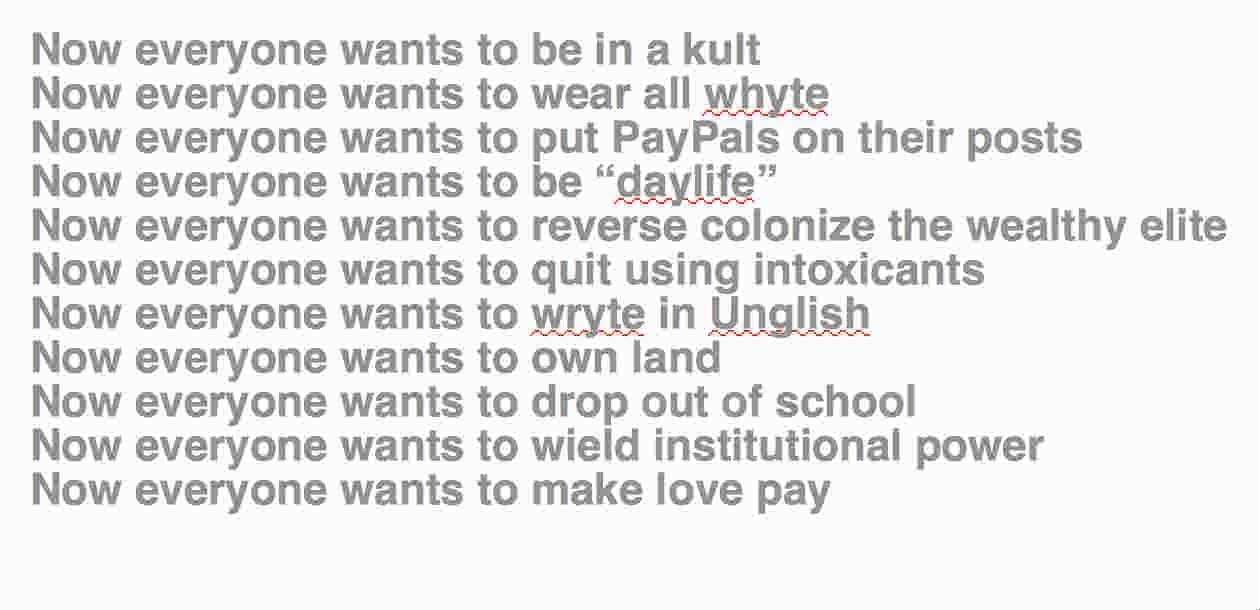“Cult” is pejorative. It’s used to characterize new religious movements as abusive, antisocial, and authoritarian. Religious groups don’t typically self-identify as such. So, when I posed the question to the friends and followers of my personal Facebook account, “are there any actual religious cults which have coalesced around an individual’s social media presence?” I didn’t expect the answer to be “yes—additionally I am in one.”
I had no idea I was already networked with a self-proclaimed “cult” on social media.
Tumple is a new religious movement which recruits from trendy “Weird Facebook” communities. The the group was cofounded by Wiz-El, a 49-year-old white man whose looks fall somewhere between Slavoj Žižek and the Ancient of Days, and Koa Malone, a 39-year-old black woman from Pittsburgh who is a former Jehovah’s Witness. According to Koa, she and Wiz developed Tumple’s religious philosophy when the two of them met in 2013 and realized they had both independently developed the same view of “the philosopher’s stone”—Koa as a practitioner of African diasporic spirituality, and Wiz from the standpoint of Gnostic Christianity.
The philosopher’s stone—the Pearl of Great Price—is, according to Koa and Wiz, sacred sex. Tumple’s website sells lessons in their mystic sex practices, called “Pearl Divun’,” for a $2,000 monthly fee. The website promises, “This comprehensive practice effectively ends the practitioner’s spiritual journey. No more yoga, no more meditation or positive thinking required.” The page claims that this technique was practiced by “Jesus, Mohammed, Buddha, Mary Magdalene, Odysseus, the Queen of Sheba and King Arthur.”
I was not given any technical details about Tumple’s sex magic practices by any of its members (which is perhaps understandable given the very high monetary value they place on it). I was told, however, that their sexual alchemy is not “free love.” Wiz-El said, “Immaculate boundaries are required and expectud of everywun who has any contact w thys more sacrud and sensityve informatiun.” The only possible hint of any details about these mystical sex practices came from an admin of the popular “Baby’s Names” Facebook page, Omaybo, who claimed in a conversation with me that Wiz-El had once tried to recruit them and that—akin to the sex magic of notorious occultist Aleister Crowley—Wiz “would tell people they need to eat their cum and blood to enhance some kind of mystical powers.”
Tumple’s foundational spiritual practice is “FlyWheelun’.” The FlyWheelun’ program is considerably less expensive than Pearl Divun’, at just $1,000 a month for half a year. Wiz-El told me that “[FlyWheelun’] is pretty basic image stuff” and that it’s “getting dreams large enuf to grapple w yr worst fears.” I asked him if he meant something like visualization, and he said, “Its like lazy visualizatiun. Its like Tumblr.” Since this was quite vague, I asked Ekin Erkan, who was formerly in the process of joining Tumple, to tell me what they knew about it. Erkan said that FlyWheelun’ is “making a board/poster that details one’s dreams/ideals…where they would like to live, how much money, how they would like to look, etc.”
Unlike the somewhat more popular occult practice of “sigil” making, FlyWheelun’ doesn’t ever attempt to encrypt what the symbols of the devotee’s desire signify, to break the chain of signification. The practice, as I understand it, is pure collage. Erkan said, “[Tumple’s] teachings follow a plot of self-actualization with projecting the imaginary and symbolic.” The cult member’s work here consists solely of perfecting their mirror, refining the representation of their ideal image, with nothing else further required to forward this image into the unconscious.
According to Koa, the cult currently has 12 full members and 50-100 people who hover on the periphery. The group’s first member—Matthew “Buum” Farrell, 21, a self-described “patient zero”—was recruited in 2013 during the height of the Alt Lit phenomenon. Buum says that he was “tryna become an underground famous racyst DJ” and that Wiz-El trolled him online until his brand was destroyed. By confronting Buum, Wiz was “havyn a real relatiunshyp wyth [him] onlyne when no1 else was.” His plan to become a famous racist DJ thwarted, Buum says that the next logical step was for him to “posse up” with the cult that trolled him online.
The cult’s essential philosophical framework will sound familiar to anyone who has heard of Chaos Magic or The Secret: Beliefs are a tool (and sex is magical). Tumple can therefore be described as a metadiscourse, or, as Wiz-El calls it, “the story of stories.”
“We call ourselvus a cult because we deal w all tha biggies—sex death burth marraige,” Wiz told me. The idiosyncratic way of typing that members adopt, known as “Unglish,” is related to this metadiscourse. Wiz said, “tha writtun traditiun represunts powur.” In the dialectic of Tumple, written language corresponds with whiteness, maleness, money, objectivity, pain, and order; whereas oral language corresponds with femaleness, blackness, time, culture and pleasure.
Unglish is both an attempt to avoid boredom, following the “Tumplar pleasure ethic,” and to find what Wiz calls “a true whyte funk.” Buum described it to me as as “lyke Jimi Hendrix solo-ing tha englysh language.” Deprogramming members from dominant social discourse is a priority of Tumple’s religious instruction. “Tha whytepain racial re-education program we hav duz that—healyn tha whytepain whych iz curruntly plaguing tha planet nd owrselves,” Buum told me. According to Koa, “what the world operates on is a white methodology.”
Koa seemed to use the phrases “white methodology” and “white pain” synonymously, perhaps indicating a view that the inner turmoil of white people is responsible for the superstructure of industrial society:
The methodology that knows about pleasure is the black methodology. If we can put that methodology back in its rightful place—invaluable place—the other methodology, the white methodology, has had thousands of years to perfect itself and get right and do everything the way it needs to do it. That means you put a new platform down, a new foundation, the Black pleasure foundation. There will be plenty of white pain on top of it that’s been around to keep everything ordered.
Tumple’s pleasure ethic is thought of as opposing the Protestant work ethic. I asked Wiz-El why his cult has embraced negativity and drama, sharing self-deprecating memes on Facebook instead of pursuing more serious means of self-promotion. He said, “Were nawt rlly willin tu du stuff we dont enjoy. To tha degree it becomus wurk it dies and just becomes anothur church or business.”
Here, Tumple’s refusal of strategic work is connected to its radical embrace of the body (both as a supposed racial and sexual entity): “I know tons of white folks with the challenge of owning the beauty and power that comes with the methodology that is in their DNA, that is in their genetic storyline for hundreds and thousands and years,” Koa told me. “Once…someone can own that and stand in the power of it, they neither oppress nor repress. They don’t repress themselves; they won’t oppress others.”
The pleasure ethic is perhaps most fully expressed in the “daylife” lifestyle prescribed for devotees. Daylife (as opposed to “nightlife”) is a kind of sober Epicureanism. The daylife practitioner does not escape from the pain and repression of the capitalist marketplace through intoxication or overindulgence; they never work and instead live a life dedicated to pleasure (while wearing all white, naturally). Buum described it as: “Beyung yrself monday morning.. relaxud lyght colours.. unpackagud nd unfulturd.. brynging tha enurgy frum tha club to thu board room.. uxpensyve art, premium relatiunshyps, kults, naps, sex, boundarius, consumptiun…sobur kulture centerud arownd relatiunshyps rathur than products or intoxicants, tha holy spirit via memes.”
I asked Wiz if Tumple has any particular rituals or prayers, and he responded, “We have hashtags.” He doesn’t do incantations because he is easily bored and disdains anything that feels repetitive. If one considers the purpose of ritual to be to reproduce ideology, then a hashtag is as good as anything. He told me that his life is normal except for wearing all white and spending “[perhaps] 14x tha amount of tume online enjoyin mysulf.” Tumple teaches that when you finish your spiritual journey, you are actually finished practicing. Wiz said, “I did our practices for a number of years and studied intently bla bla bla and now [I’m] kinda done.”

Some critics of Tumple allege that they take this unconventional approach because they are actually devoid of real substance. At one point, Skaar Laureano enjoyed Tumple livestreams and had intended to become a paying member. He said he was attracted to the image they portrayed of “having the knowledge of almost everything and how they had ‘positive vibes.’” “[Tumple] painted a pretty solid picture in my head when I was going through some very tough times,” Skaar told me. He backed out, however, when he saw screenshots that demonstrated Buum and Wiz making racist comments to “someone who refused to pay.” Skaar has since come to the conclusion that Tumple doesn’t actually have any real spiritual teachings. “They are under no religion except money, and they simply are sort of a disease online,” he said. While calling Tumple “scam artists,” Skaar said, “I believe that they did have potential at one point in time. But they are the prime example of how money can corrupt such a potentially positive group of individuals.”
According to Omaybo, Wiz-El and Koa are now living in a rental car in Southern California, where they are proselytizing on the road. While Tumple does pay all of its staff members, the daylife is not yet as luxurious as it purports to be. Some Tumple staff members, like Buum, live at home with their parents. Koa, however, has a “2000 year plan.” Multigenerational planning, Koa said, is a strategy she has adopted from the bourgeois elite. It’s a bit longer of a timeframe than most families use, though, because you have to consider the lifespan of a religion. However, Koa remarked that “a lot of the things I would like to implement in the 2000 year plan could take 20 years.”
“We are hurtling towards the singularity and it really does exponentially shrink down the time it takes to do something,” she explained.
Certainly “hurtling towards the singularity” can also change the kinds of things people want to do. I was curious about social media cults because I assumed that a cult that had sprung up on social media would be unrecognizable in comparison to a cult such as Jehovah’s Witnesses, which had gotten its start with industrial media. Instead of distributing print media as religious praxis, meditating, or praying, Tumple has hashtags. It has “tha holy spirit via memes.”
Because the movement was formed on social media, the subjective experience of the devotee becomes much less relevant to how its ideology is propagated than smashing the like, or PayPal, button. Self-awareness also hurtles toward the singularity as Tumple extends beyond irony in calling itself a “cult.” Tumple is not like the ironic cults of the 1960s and ’70s counterculture (e.g., Discordianism or SubGenius). Tumple’s beliefs are completely sincere—yet it has enough of a sense of humor to make its ulterior motives totally transparent.
Update 12:08pm CT, Oct. 28: Buum no longer supports or is affiliated with Tumple.






